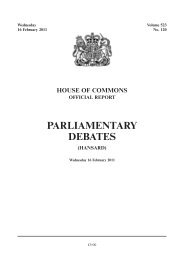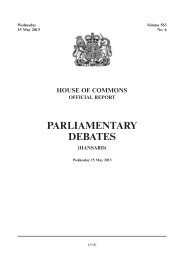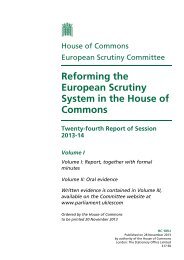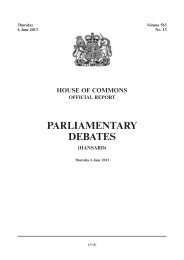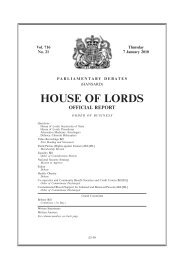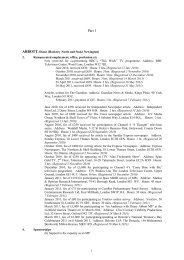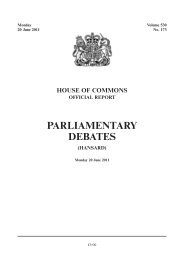Ticketing and Concessionary Travel on Public Transport - United ...
Ticketing and Concessionary Travel on Public Transport - United ...
Ticketing and Concessionary Travel on Public Transport - United ...
Create successful ePaper yourself
Turn your PDF publications into a flip-book with our unique Google optimized e-Paper software.
Ev 66 <strong>Transport</strong> Committee: Evidence<br />
2. When I want to take my bike <strong>on</strong> the train, there are additi<strong>on</strong>al barriers. I can’t reserve my bike place<br />
<strong>on</strong> line any more, because they’ve removed the opti<strong>on</strong> from <strong>on</strong>line ticketing systems. So, if I want to reserve<br />
a bike place, I have to visit the stati<strong>on</strong>. What’s the point in having bought the ticket <strong>on</strong>line in the first place?<br />
February 2007<br />
Integrated <str<strong>on</strong>g>Ticketing</str<strong>on</strong>g><br />
Memor<str<strong>on</strong>g>and</str<strong>on</strong>g>um from Iosis Associates (TPT04)<br />
1. Is ticketing suYciently integrated across diVerent modes of transport <str<strong>on</strong>g>and</str<strong>on</strong>g> between diVerent geographical<br />
areas?<br />
2. From my point of view, in general terms, nowhere near, despite the 1998 Integrated <strong>Transport</strong> White<br />
Paper <str<strong>on</strong>g>and</str<strong>on</strong>g> the new Bus White Paper “Putting Passengers First”. The new White Paper totally ignores<br />
integrated ticketing, although it does menti<strong>on</strong> “through ticketing” without defining the term. Also the new<br />
White Paper is generally internally inc<strong>on</strong>sistent <str<strong>on</strong>g>and</str<strong>on</strong>g> sloppy in its use of terms. See the Annexes to this<br />
submissi<strong>on</strong> for analysis <str<strong>on</strong>g>and</str<strong>on</strong>g> comment <strong>on</strong> the White Paper.<br />
3. My viewpoints are two:<br />
— that of passenger, using bus services in my local near-metropolitan area (Greater Bristol), bus<br />
services in other areas that I visit, l<strong>on</strong>g distance coach services, heavy rail services, metro services<br />
(eg L<strong>on</strong>d<strong>on</strong>), <str<strong>on</strong>g>and</str<strong>on</strong>g> the half-way house of Merseyrail Electrics; <str<strong>on</strong>g>and</str<strong>on</strong>g><br />
— that of technologist in ICT areas that include the ITSO secure ticketing <str<strong>on</strong>g>and</str<strong>on</strong>g> journey management<br />
envir<strong>on</strong>ment<br />
4. As with so many questi<strong>on</strong>s in an area of service delivery to a large number of people, the 80/20 rule<br />
comes into play. If the service oVered is perfectly adequate for 80% of the people or for 80% of the<br />
transacti<strong>on</strong>s, is that good enough? DiVerent situati<strong>on</strong>s of course produce diVerent splits 60/40, 90/10, 99.99/<br />
0.01 . . . DiVerent people will therefore give diVerent opini<strong>on</strong>s.<br />
5. In terms of expectati<strong>on</strong>s following the 1998 Integrated <strong>Transport</strong> White Paper, the answer to the<br />
Committee’s questi<strong>on</strong> is overall “No”. In terms of the desire to minimise the growth of private car traYc,<br />
even reduce it, the answer is very definitely an overall “No”.<br />
6. Geographically, in some areas of the country the answer is “Almost Yes <str<strong>on</strong>g>and</str<strong>on</strong>g> improving”—L<strong>on</strong>d<strong>on</strong> is<br />
the example most often cited as having good ticketing provisi<strong>on</strong>. Oyster dem<strong>on</strong>strates, as does for example<br />
the current nati<strong>on</strong>al scheme in The Netherl<str<strong>on</strong>g>and</str<strong>on</strong>g>s, that integrati<strong>on</strong> must be organised <str<strong>on</strong>g>and</str<strong>on</strong>g> managed at the<br />
level of a natural geographical <str<strong>on</strong>g>and</str<strong>on</strong>g> demographic regi<strong>on</strong>. To some extent the PTEs have been able to provide<br />
integrati<strong>on</strong> across diVerent operators <str<strong>on</strong>g>and</str<strong>on</strong>g> even, as in Merseyside, across bus <str<strong>on</strong>g>and</str<strong>on</strong>g> rail modes. But overall the<br />
applicati<strong>on</strong> of competiti<strong>on</strong> law has brought about a deteriorati<strong>on</strong> in the progress of integrati<strong>on</strong>, <str<strong>on</strong>g>and</str<strong>on</strong>g> has<br />
even caused the ceasing of some integrated ticketing schemes.<br />
7. To people who live in another town or city that has public transport that the local residents rate as<br />
“poor” together with heavily c<strong>on</strong>gested roads (eg Greater Bristol, which does not have a PTE <str<strong>on</strong>g>and</str<strong>on</strong>g> has<br />
recently been described as the largest metropolitan area in the country that is not a metropolitan county),<br />
<strong>on</strong>ce we learn how the Oyster scheme works we want it in our area. Those of us who know that the current<br />
Oyster technology is not scalable <str<strong>on</strong>g>and</str<strong>on</strong>g> not interoperable with cl<strong>on</strong>es of itself in other urban centres are aware<br />
that the forthcoming overlaying of ITSO technology <strong>on</strong> the Oyster scheme will be a bo<strong>on</strong>.<br />
8. The initial integrati<strong>on</strong> of further heavy rail L<strong>on</strong>d<strong>on</strong> local services into the Oyster scheme is a start, but<br />
essential is resolute <str<strong>on</strong>g>and</str<strong>on</strong>g> expert progress with the growing commitment by DfT to ensure that l<strong>on</strong>ger distance<br />
heavy rail services implement ITSO technology <str<strong>on</strong>g>and</str<strong>on</strong>g> do it properly. However, the l<strong>on</strong>ger distance heavy rail<br />
service ticketing provisi<strong>on</strong>, currently supposedly at the start of implementati<strong>on</strong>, is the subject of very<br />
c<strong>on</strong>siderable internal disagreement within the industry, <str<strong>on</strong>g>and</str<strong>on</strong>g> DfT gives all the appearance of not having the<br />
expertise or knowledge to resolve the problems.<br />
9. We should temper the answer “No” with an assessment of the possibility of doing better without<br />
significant extra cost. Here we frequently hear about, <str<strong>on</strong>g>and</str<strong>on</strong>g> some of us experience for ourselves, public<br />
transport systems in European cities or further afield (eg the far east) that in metropolitan areas are better<br />
integrated. If we look at the diVerence between their way of doing things <str<strong>on</strong>g>and</str<strong>on</strong>g> ours, we very often see a<br />
publicly owned service (eg Brussels, Paris), or at least a much better partnership between public <str<strong>on</strong>g>and</str<strong>on</strong>g> private<br />
sector (eg Holl<str<strong>on</strong>g>and</str<strong>on</strong>g>). In fact Holl<str<strong>on</strong>g>and</str<strong>on</strong>g> is a good place to study, for they are currently installing a fully<br />
integrated public transport ticketing system from <strong>on</strong>e of the <strong>on</strong>ly two companies recognised as being capable<br />
of delivering (with suitable partners) a fully integrated ticketing system over a complex multi-modal<br />
network. 1<br />
1 Holl<str<strong>on</strong>g>and</str<strong>on</strong>g> is using Thales, whereas L<strong>on</strong>d<strong>on</strong> uses Cubic.



